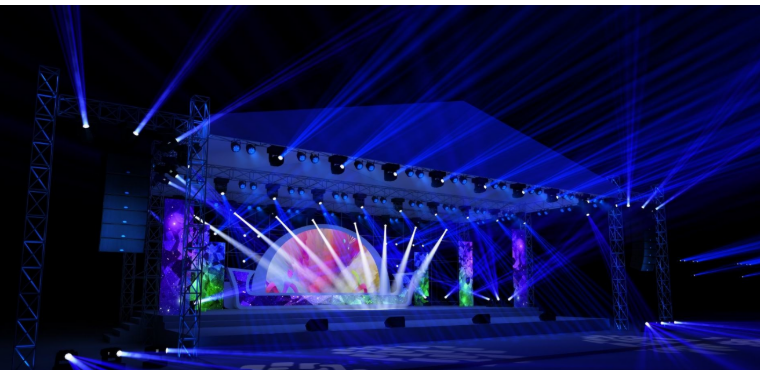Introduction: Why Lighting Coordination Defines Stage Aesthetics
Stage lighting is more than just illumination—it is the invisible hand that shapes mood, depth, and atmosphere. In stage design, the key light plays the primary role in defining the subject, while fill lights support by softening shadows, balancing contrast, and ensuring that performers are visible under different conditions. Striking the right balance between these two is both a science and an art.
This article explores the coordination principles between fill lights and key lights in stage environments, emphasizing their importance in performance aesthetics, technical setups, and artistic creativity. Supported by insights from professionals at Blue Sea Lighting,we will dive into the psychology, technical aspects, and real-world applications of light balance.

1. Understanding the Role of the Key Light
The key light is the primary source of illumination in a scene or performance. It determines the overall exposure, direction, and mood.
Defining Shape and Depth: Positioned to one side, the key light creates shadows that give three-dimensionality to the subject.
Mood Creation: Harsh, angled key lights can create drama, while soft, diffused ones evoke warmth.
Highlighting the Subject: Whether it’s a lead actor or a solo musician, the key light ensures that the audience’s focus is clear.
2. The Role of Fill Lights
Fill lights are secondary sources that serve to reduce contrast and soften shadows without overpowering the key light.
Shadow Control: Fill light eliminates harsh black spots created by strong key lights.
Balancing Brightness: Ensures no part of the stage appears excessively dark.
Audience Comfort: Reduces visual fatigue by preventing overexposed or underlit areas.
Fill lights must be subtle. Overuse diminishes the dramatic impact of the key light, while underuse makes the stage look unbalanced.
3. Principles of Coordination
Principle 1: Maintain a Ratio
The most common principle is the lighting ratio—the balance of brightness between the key light and the fill light.
A 2:1 ratio is standard in theater, giving depth without overwhelming shadows.
A 3:1 or higher ratio is used in dramatic performances where shadows enhance mood.
Principle 2: Control Direction
Fill lights should generally come from the opposite side of the key light to reduce harsh shadows.
Avoid direct opposition, which cancels shadows and flattens the scene.
Principle 3: Use Softening Tools
Diffusers, reflectors, and frosted filters on fill lights prevent them from overpowering the subject.
Indirect bounce lighting can create a natural soft effect.
Principle 4: Adapt to Performance Style
In dance performances, brighter fill lights maintain clarity of motion.
In dramatic theater, minimal fill enhances emotion and mystery.
4. Psychological Effects of Light Balance
Lighting doesn’t just illuminate—it influences audience perception:
Balanced Lighting: Creates comfort, professionalism, and clarity.
High Contrast (low fill): Produces tension, mystery, and emotional intensity.
Low Contrast (high fill): Suggests harmony, openness, and warmth.
Directors and lighting designers often exploit these psychological triggers to shape audience response.
5. Technical Considerations
Fixture Positioning
Key light: Usually placed at a 45° vertical and horizontal angle to the performer.
Fill light: Positioned closer to eye level and slightly off-center.
Color Temperature
Consistency between key and fill lights ensures natural skin tones.
Variations in color can be used for creative effect (e.g., warm fill with cool key light).
Intensity Control
Dimmers and DMX systems allow fine adjustments to maintain the correct balance during performances.
6. Real-World Applications
Theater: A Shakespearean tragedy might use sharp key lighting with minimal fill to heighten drama.
Concerts: Balanced key-fill setups ensure singers remain visible even with bright stage effects.
Television: News broadcasts rely on precise 2:1 ratios for clarity and professionalism.
Dance Shows: Fill lights keep rapid movements visible, avoiding shadows that disrupt audience perception.
7. Innovations in Key and Fill Lighting
With LED and intelligent lighting technologies, the coordination of key and fill lights has become more dynamic:
Automated Dimming Systems adjust ratios in real-time.
Color-Changing LEDs allow creative fill effects without needing gels.
Programmable Moving Heads reposition key-fill relationships throughout a performance.
These innovations, supplied by companies like Blue Sea Lighting, empower designers with flexibility.
8. Best Practices from Professionals
Never Flatten the Scene: Too much fill destroys drama.
Experiment with Ratios: Adjust based on genre, venue, and emotional goals.
Integrate with Other Lights: Fill and key must harmonize with backlights, sidelights, and specials.
Adapt for Camera: Stage setups for live streaming may require different fill-to-key ratios than for in-person audiences.
Conclusion
The art of stage lighting is built upon balance. The key light defines and directs, while the fill light refines and supports. Mastering the coordination between them is essential for crafting visually stunning, emotionally resonant performances. With evolving technologies and guidance from innovators like Blue Sea Lighting, lighting designers are equipped to turn stages into immersive worlds.





Blue Sea Lighting is an enterprise with rich experience in the integration of industry and trade in stage lighting and stage special effects related equipment. Its products include moving head lights, par lights, wall washer lights, logo gobo projector lights, power distributor, stage effects such as electronic fireworks machines, snow machines, smoke bubble machines, and related accessories such as light clamps.
Quick Links
For more questions subscribe to our email








